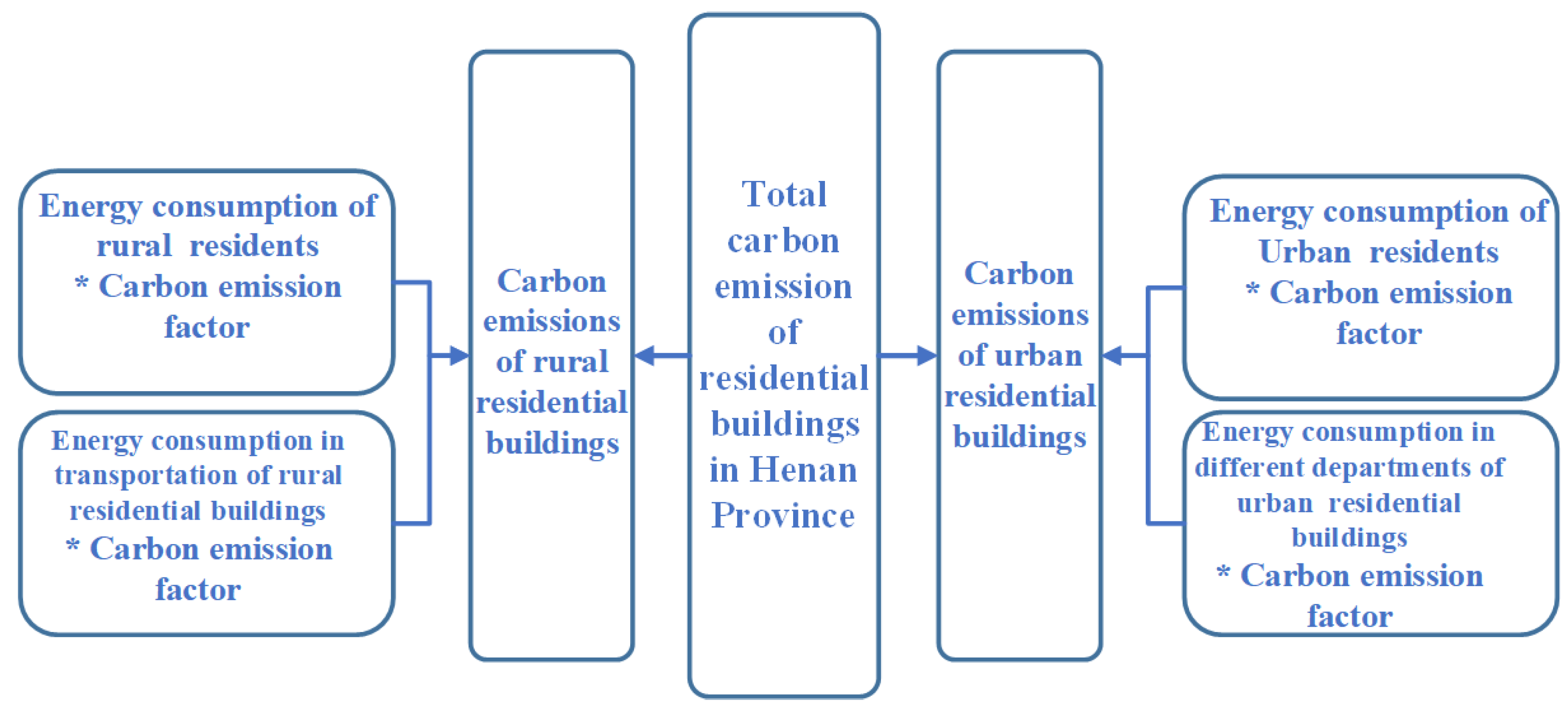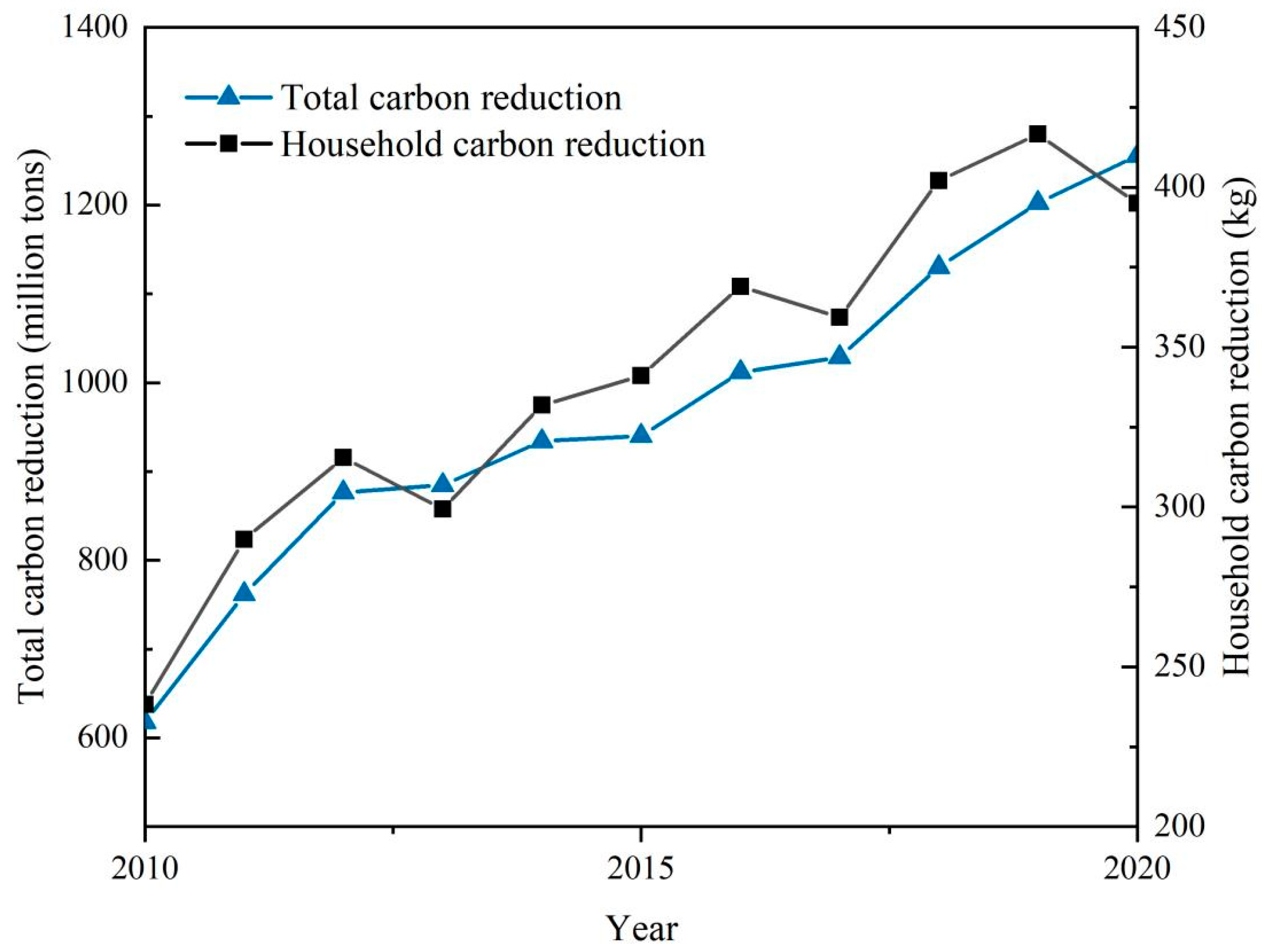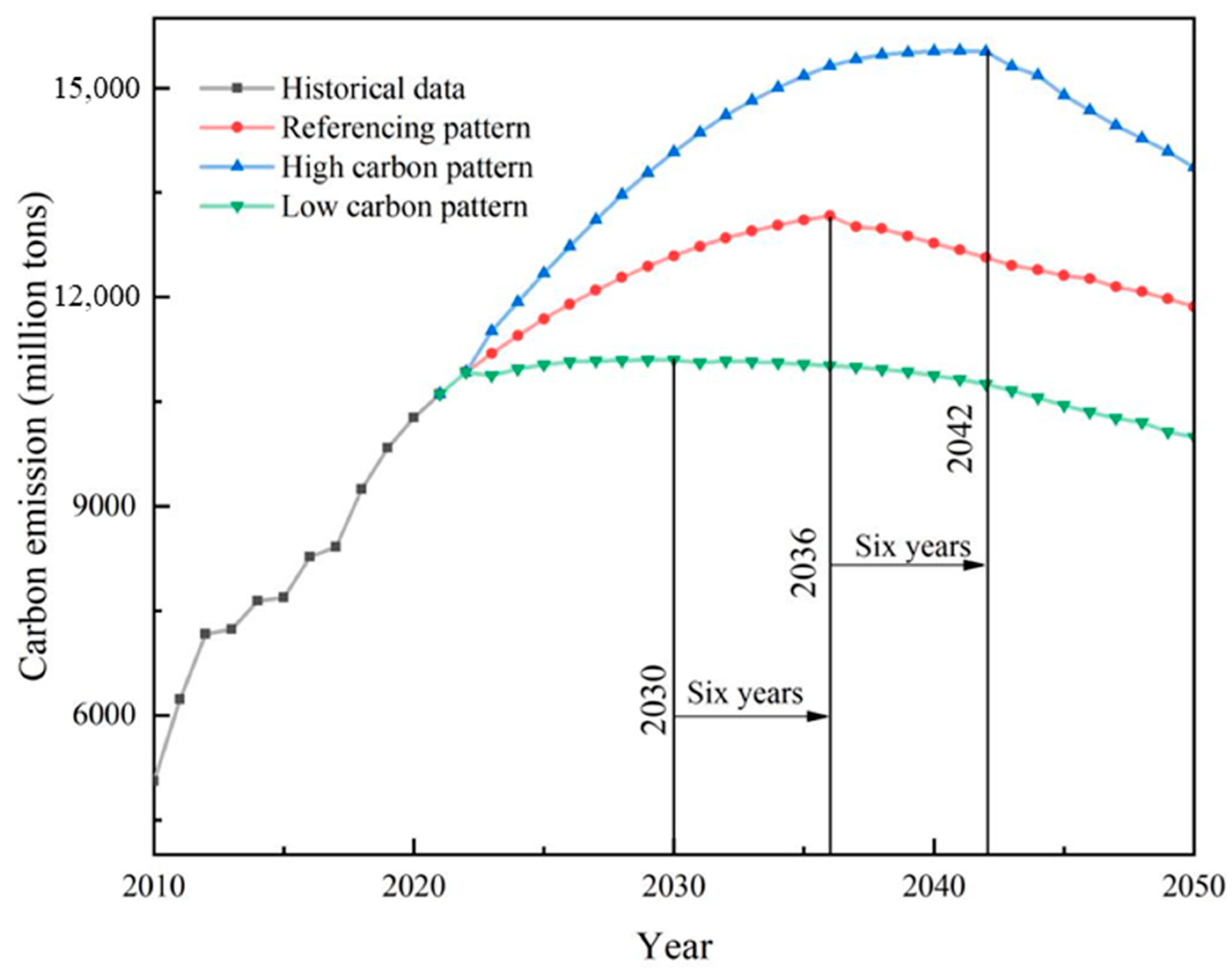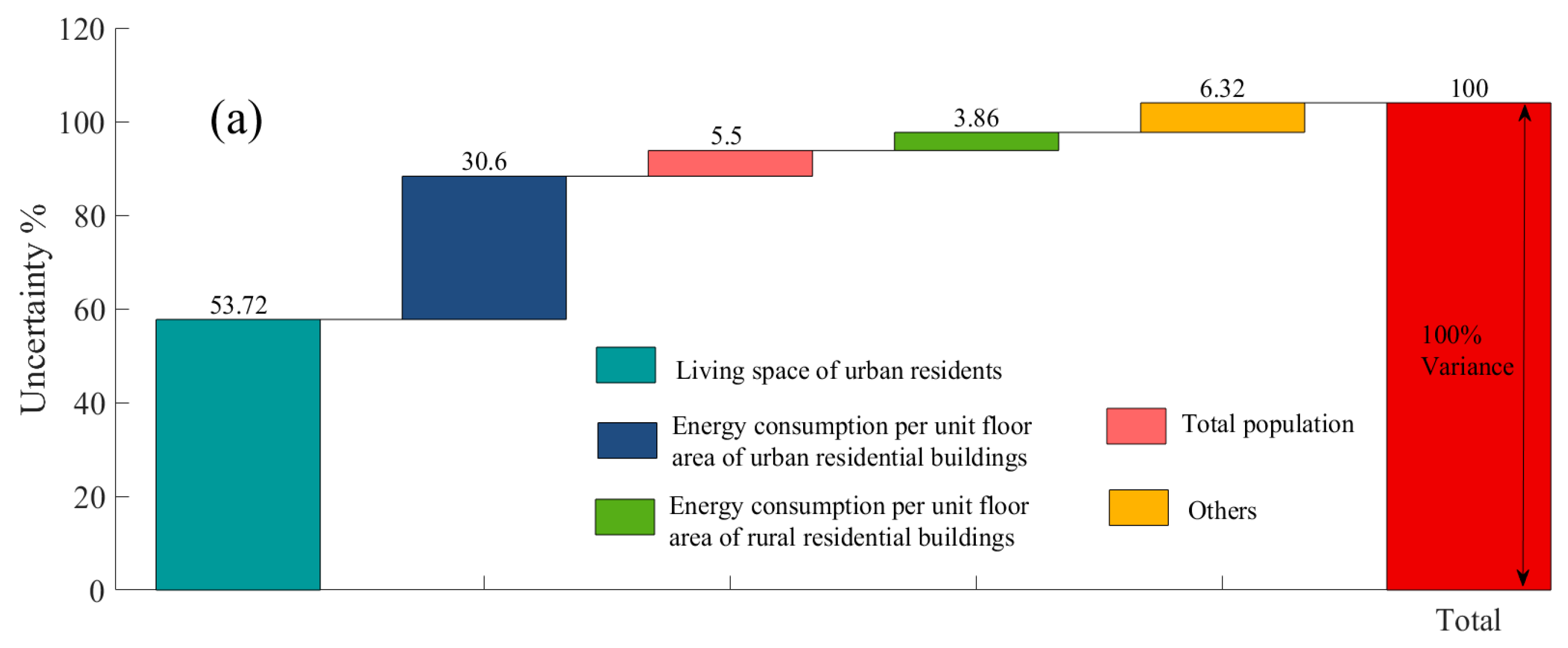Research on Influencing Factors of Residential Building Carbon Emissions and Carbon Peak: A Case of Henan Province in China
Abstract
:1. Introduction
2. Data Sources and Research Methodology
2.1. Source of Data
2.2. Carbon Emission Accounting Methods
2.3. Data Processing
2.4. Calculation Results
3. Evaluation of Historical Reductions in CO2 Emissions from Residential Buildings
3.1. The Kaya Identity
3.2. LMDI Decomposition Method
3.3. Analysis of Kaya-LMDI Decomposition Results
3.4. Historical Carbon Emission Reduction and Reduction Degree of Residential Buildings
4. Simulation of Peak Carbon Emissions from Residential Buildings
4.1. Static Scenario Analysis
4.2. Dynamic Scenario Analysis for Peak Residential Building Carbon Emissions
5. Discussion and Innovations
5.1. Discussion
5.2. Innovations
6. Conclusions
Author Contributions
Funding
Institutional Review Board Statement
Informed Consent Statement
Data Availability Statement
Conflicts of Interest
References
- Nkemelang, T.; New, M.; Zaroug, M. Temperature and precipitation extremes under current, 1.5 °C and 2.0 °C global warming above pre-industrial levels over Botswana, and implications for climate change vulnerability. Environ. Res. Lett. 2018, 13, 065016. [Google Scholar] [CrossRef] [Green Version]
- Li, F.; Liu, J.; Liu, W.; Liao, S. Spatiotemporal dynamics analysis of carbon emissions from nighttime light data in Beijing-Tianjin-Hebei counties. J. Xinyang Norm. Univ. (Nat. Sci. Ed.) 2021, 34, 230–236. [Google Scholar]
- Li, X.; Zhao, X. An empirical analysis on the impact of air pollution on green transportation consumption. J. Xinyang Norm. Univ. (Nat. Sci. Ed.) 2022, 35, 591–596. [Google Scholar]
- Wang, G.; Liao, M.; Jiang, J. Research on agricultural carbon emissions and regional carbon emissions reduction strategies in China. Sustainability 2020, 12, 2627. [Google Scholar] [CrossRef] [Green Version]
- Wang, Y.; Yao, G.; Zuo, Y.; Wu, Q. Implications of global carbon governance for corporate carbon emissions reduction. Front. Environ. Sci. 2023, 11, 1071658. [Google Scholar] [CrossRef]
- Xiao, M.; Peng, X. Decomposition of carbon emission influencing factors and research on emission reduction performance of energy consumption in China. Front. Environ. Sci. 2022, 10, 1096650. [Google Scholar] [CrossRef]
- Huo, T.; Li, X.; Cai, W.; Zuo, J.; Jia, F.; Wei, H. Exploring the impact of urbanization on urban building carbon emissions in China: Evidence from a provincial panel data model. Sustain. Cities Soc. 2020, 56, 102068. [Google Scholar] [CrossRef]
- Huo, T.; Tang, M.; Cai, W.; Ren, H.; Liu, B.; Hu, X. Provincial total-factor energy efficiency considering floor space under construction: An empirical analysis of China’s construction industry. J. Clean. Prod. 2020, 244, 118749. [Google Scholar] [CrossRef]
- Xiao, D.; Niu, H.; Guo, J.; Zhao, S.; Fan, L. Carbon Storage Change Analysis and Emission Reduction Suggestions under Land Use Transition: A Case Study of Henan Province, China. Int. J. Environ. Res. Public Health 2021, 18, 1844. [Google Scholar] [CrossRef]
- Kaya, Y. Impact of Carbon Dioxide Emission Control on GNP Growth: Interpretation of Proposed Scenarios; Intergovernmental Panel on Climate Change/Response Strategies Working Group: Geneva, Switzerland, 1990. [Google Scholar]
- Kavgic, M.; Mavrogianni, A.; Mumovic, D.; Summerfield, A.; Stevanovic, Z.; Djurovic-Petrovic, M. A review of bottom-up building stock models for energy consumption in the residential sector. Build. Environ. 2010, 45, 1683–1697. [Google Scholar] [CrossRef]
- Fankhauser, S.; Tol, R.S. The social costs of climate change: The IPCC second a ssessment report and beyond. Mitig. Adapt. Strateg. Glob. Chang. 1997, 1, 385–403. [Google Scholar] [CrossRef] [Green Version]
- Boyd, G.; Mcdonald, J.F.; Ross, M.; Hanson, D. Separating the changing composition of US manufacturing production from energy efficiency improvements: A Divisia index approach. Energy J. 1987, 8, 77–96. [Google Scholar] [CrossRef]
- Swan, L.G.; Ugursal, V.I. Modeling of end-use energy consumption in the residential sector: A review of modeling techniques. Renew. Sustain. Energy Rev. 2009, 13, 1819–1835. [Google Scholar] [CrossRef]
- Ang, B.W.; Choi, K.H. Decomposition of Aggregate Energy and Gas Emission Inten sities for Industry: A refined Divisia index method. Energy J. 1997, 18, 59–73. [Google Scholar] [CrossRef]
- Guo, S.; Liu, G.; Liu, S. Driving factors of NOX emission reduction in China’s power industry: Based on LMDI decomposition model. Environ. Sci. Pollut. Res. 2023, 30, 51042–51060. [Google Scholar] [CrossRef]
- Li, H.; Zheng, Y.; Gong, G.; Guo, H. A simulation study on peak carbon emission of public buildings: In the case of henan province China. Sustainability 2023, 15, 8638. [Google Scholar] [CrossRef]
- Liu, M.; Yang, X.; Wen, J.; Wang, H.; Feng, Y.; Lu, J.; Chen, H.; Wu, J.; Wang, J. Drivers of China’s carbon dioxide emissions: Based on the combination model of structural decomposition analysis and input-output subsystem method. Environ. Impact Assess. Rev. 2023, 100, 107043. [Google Scholar] [CrossRef]
- Ali, U.; Shamsi, M.H.; Hoare, C.; Mangina, E.; O’Donnell, J. Review of urban building energy modeling (UBEM) approaches, methods and tools using qualitative and quantitative analysis. Energy Build. 2021, 246, 111073. [Google Scholar] [CrossRef]
- Ang, B.W. LMDI decomposition approach: A guide for implementation. Energy Policy 2015, 86, 233–238. [Google Scholar] [CrossRef]
- Peng, C.; Wei, Q.; Wei, W. Decarbonization path of China’s public building sector from bottom to top. Carbon Neutrality 2022, 1, 39. [Google Scholar] [CrossRef]
- Qi, Y.; Rao, G.; Zha, L.; Chen, L.; Niu, Y. Carbon Transfer Decision Model Based on LMDI Method. Comput. Intell. Neurosci. 2022, 3970880, 3970880. [Google Scholar] [CrossRef] [PubMed]
- Ma, M.; Cai, W.; Cai, W. Carbon abatement in China’s commercial building sector: A bottom-up measurement model based on Kaya-LMDI methods. Energy 2018, 165, 350–368. [Google Scholar] [CrossRef]
- Lu, Y.; Cui, P.; Li, D. Which activities contribute most to building energy consumption in China? A hybrid LMDI decomposition analysis from year 2007 to 2015. Energy Build. 2018, 165, 259–269. [Google Scholar] [CrossRef]
- Henan Statistical Bureau. In China Energy Statistical Yearbook 2010–2020; China Statistics Press: Beijing, China, 2020.
- National Bureau of Statistics of China. In China Statistical Yearbook 2010–2020; China Statistics Press: Beijing, China, 2020.
- Chen, h.; Bi, L. Study on spatio-temporal changes and driving factors of carbon emissions at the building operation stage: A case study of China. Build. Environ. 2022, 219, 109147. [Google Scholar] [CrossRef]
- Huo, T.; Ren, H.; Zhang, X.; Cai, W.; Feng, W.; Zhou, N.; Wang, X. China’s energy consumption in the building sector: A Statistical Yearbook-Energy Balance Sheet based splitting method. J. Clean. Prod. 2018, 185, 665–679. [Google Scholar] [CrossRef]
- Zhou, X.; Huang, Z.; Bronte, S.; Wang, H.; Zhou, G.; Liu, Y. High-resolution estimation of building energy consumption at the city level. Energy 2023, 275, 127476. [Google Scholar] [CrossRef]
- Wang, P.; Wu, P.; Song, Y.; Keith, H.; Zhong, Y. A novel spatio-temporally stratified heterogeneity model for identifying factors influencing carbon emissions. Energy Build. 2023, 280, 112714. [Google Scholar] [CrossRef]
- Wakazono, Y.; Kato, T.; Hayakawa, N.; Suzuoki, Y.; Kaya, Y. Feasibility assessment of efficient, environmentally benign and economic heat combinat by cascade use of waste energy in industries. IEEJ Trans. Power Energy 1999, 119, 1026–1034. [Google Scholar] [CrossRef] [Green Version]
- Ma, M.; Ma, X.; Cai, W. Carbon roadmap of residential building sector in China: Historical mitigation and prospective peak. Appl. Energy 2020, 273, 115247. [Google Scholar] [CrossRef]
- Wen, L.; Li, Z. Provincial-level industrial CO2 emission drivers and emission reduction strategies in China: Combining two-layer LMDI method with spectral clustering. Sci. Total Environ. 2020, 700, 134374. [Google Scholar] [CrossRef]
- Lou, Y.; Ye, Y.; Yang, Y.; Wang, Z. Long-term carbon emission reduction potential of building retrofits with dynamically changing electricity emission factors. Build. Environ. 2022, 210, 108683. [Google Scholar] [CrossRef]
- Postma, T.; Liebl, F. How to improve scenario analysis as a strategic management tool? Technol. Forecast. Soc. Chang. 2005, 72, 161–173. [Google Scholar] [CrossRef]
- Ma, M.; Cai, W. What drives the carbon mitigation in Chinese commercial building sector? Evidence from decomposing an extended Kaya identity. Sci. Total Environ. 2018, 634, 884–899. [Google Scholar] [CrossRef]
- National Bureau of Statistics of China. In China Population & Employment Statistics Yearbook 2010–2020; China Statistics Press: Beijing, China, 2020.
- Huo, J.; Zhang, X.; Zhang, Z.; Chen, Y. Research on population development in ethnic minority areas in the context of China’s population strategy adjustment. Sustainability 2020, 12, 8021. [Google Scholar] [CrossRef]
- Fan, Y.; Liu, Q.; Huang, X.; Li, M.; He, B.; Guo, W.; Wang, Y. Study on the characteristics of China’s population spatial Pattern and influencing factors based on mobile phone signaling data. J. Xinyang Norm. Univ. (Nat. Sci. Ed.) 2022, 35, 584–590. [Google Scholar]
- Xu, G.; Li, J.; Peter, M.S.; Yang, H.; Chang, H. Rural financial development and achieving an agricultural carbon emissions peak: An empirical analysis of Henan Province, China. Environ. Dev. Sustain. 2022, 24, 12936–12962. [Google Scholar] [CrossRef]
- Zhang, P.; He, J.; Hong, X.; Zhang, W.; Qin, C.; Pang, B.; Li, Y.; Liu, Y. Regional-level carbon emissions modelling and scenario analysis: A STIRPAT case study in Henan Province, China. Sustainability 2017, 9, 2342. [Google Scholar] [CrossRef] [Green Version]
- Huang, Y.; Gao, J.; Zhang, Y.; Zhang, X. Comprehensive poverty types in typical agricultural areas and their spatial evolution. J. Xinyang Norm. Univ. (Nat. Sci. Ed.) 2022, 35, 446–452. [Google Scholar]
- Chen, H.; Du, Q.; Huo, T.; Liu, P.; Cai, W.; Liu, B. Spatiotemporal patterns and driving mechanism of carbon emissions in China’s urban residential building sector. Energy 2023, 15, 126102. [Google Scholar] [CrossRef]
- Zhang, X.; Zhang, X. Comparison and sensitivity analysis of embodied carbon emissions and costs associated with rural house construction in China to identify sustainable structural forms. J. Clean. Prod. 2021, 293, 126190. [Google Scholar] [CrossRef]
- Luo, G.; Tomas, B.; Zeng, S. Per capita CO2 emission inequality of China’s urban and rural residential energy consumption: A Kaya-Theil decomposition. J. Environ. Manag. 2023, 331, 117265. [Google Scholar] [CrossRef] [PubMed]
- Moncef, K. Evaluation of energy performance of dynamic overhang systems for US residential buildings. Energy Build. 2021, 234, 110699. [Google Scholar]
- Su, B.; Huang, J.; Thomas, F.; Wang, Y.; Zbigniew, W.; Kundzewicz, Z.; Sun, H.; Wang, A.; Zeng, X.; Wang, G.; et al. Drought losses in China might double between the 1.5 °C and 2.0 °C warming. Proc. Natl. Acad. Sci. USA 2018, 115, 10600–10605. [Google Scholar] [CrossRef] [PubMed] [Green Version]
- Kim, Y. Monte Carlo vs. Fuzzy Monte Carlo Simulation for Uncertainty and Global Sensitivity Analysis. Sustainability 2017, 9, 539. [Google Scholar] [CrossRef] [Green Version]
- Zhou, G.; Wu, M.; Tai, Y. Spatio-temporal pattern analysis of coupling and coordination between rural development and urbanization from the perspective of rural revitalization—A case study of Henan Province. J. Xinyang Norm. Univ. (Nat. Sci. Ed.) 2021, 34, 68–75. [Google Scholar]
- Ye, X.; Chuai, X. Have rural settlement changes harmed ecosystem carbon in China. Geography 2023, 153, 102917. [Google Scholar] [CrossRef]
- Wang, F.; Wu, M.; Zheng, W. What are the impacts of the carbon peaking and carbon neutrality target constraints on China’s economy? Environ. Impact Assess. 2023, 101, 107107. [Google Scholar] [CrossRef]
- Ma, L.; Zhang, X.; Li, D.; Müslüm, A.; Çağatay, Y.; Li, Q.; Zhang, S.; Jiang, W. Influence of sunspace on energy consumption of rural residential buildings. Sol. Energy 2020, 211, 336–344. [Google Scholar] [CrossRef]







| Year | 2010 | 2011 | 2012 | 2013 | 2014 | 2015 | 2016 | 2017 | 2018 | 2019 | 2020 |
|---|---|---|---|---|---|---|---|---|---|---|---|
| Urban area | 1.8103 | 1.7587 | 1.7300 | 1.6348 | 1.6471 | 1.6128 | 1.8062 | 1.7109 | 1.7939 | 1.8347 | 1.8516 |
| Rural area | 1.1490 | 1.2006 | 1.2751 | 1.2741 | 1.3585 | 1.4216 | 1.7010 | 1.6720 | 1.6401 | 1.5596 | 1.4888 |
| Influencing Factors | The Change Rate of Carbon Emission | Household Size | Per Capita Income | Energy Consumption Per Unit Area of Buildings | Carbon Emission Factors | House Price to Income Ratio | Home Purchase Index |
|---|---|---|---|---|---|---|---|
| 2010–2013 | 11.23% | 6% | 36.36% | 2.23% | 5% | 28.70% | −55.06% |
| 2013–2016 | 5.88% | 12% | 33.96% | −1.23% | 6.70% | 10.27% | −44.90% |
| 2016–2020 | 6.53% | −1.22% | 33.39% | 2.74% | −4.31% | 20.41% | −44.48% |
| Parameters | Low Carbon Scenario | Baseline Scenario | High Carbon Scenario | References | |||
|---|---|---|---|---|---|---|---|
| Year | 2030 | 2050 | 2030 | 2050 | 2030 | 2050 | |
| Population(×104 people) | 11,530 | 11,120 | 11,530 | 11,120 | 11,530 | 11,120 | [37,38,39,40] |
| Urbanization rate (%) | 67.4 | 78 | 70 | 80 | 72 | 83 | [41,42] |
| Carbon emission factor of urban residential buildings | 1.8023 | 1.7546 | 1.8231 | 1.7852 | 1.8325 | 1.8014 | [43] |
| Carbon emission factor of rural residential buildings | 1.3842 | 1.3621 | 1.4025 | 1.384 | 1.4124 | 1.4016 | [44] |
| Energy consumption per unit area of urban residential buildings (kgce/m2) | 11.0625 | 9.5137 | 10.2879 | 8.8477 | 9.5677 | 8.4053 | [44] |
| Energy consumption per unit area of rural residential buildings (kgce/m2) | 9.1449 | 7.8665 | 8.5048 | 7.3158 | 7.9095 | 6.95 | [44] |
| Urban residential building floor area per capita (m2/person) | 45.26 | 46.42 | 47.58 | 49.17 | 48.58 | 50.2 | [44,45] |
| Rural residential building floor area per capita (m2/person) | 56.2 | 59.34 | 59.27 | 62.35 | 60.52 | 63.66 | [45] |
| Variables | Unit | Distribution Pattern of Random Parameters |
|---|---|---|
| Population | ×104 people | N (0, 0.005) |
| Urbanization rate | % | N (0, 0.02) |
| Comprehensive carbon emission factors of urban residential buildings | tCO2/tce | N (0, 0.01) |
| Comprehensive carbon emission factors of rural residential buildings | tCO2/tce | N (0, 0.01) |
| Energy consumption per unit area of urban residential buildings | kgce/m2 | N (0, 0.02) |
| Energy consumption per unit area of rural residential buildings | kgce/m2 | N (0, 0.02) |
| Urban residential building floor area per capita | m2/person | N (0, 0.03) |
| Rural residential building floor area per capita | m2/person | N (0, 0.03) |
Disclaimer/Publisher’s Note: The statements, opinions and data contained in all publications are solely those of the individual author(s) and contributor(s) and not of MDPI and/or the editor(s). MDPI and/or the editor(s) disclaim responsibility for any injury to people or property resulting from any ideas, methods, instructions or products referred to in the content. |
© 2023 by the authors. Licensee MDPI, Basel, Switzerland. This article is an open access article distributed under the terms and conditions of the Creative Commons Attribution (CC BY) license (https://creativecommons.org/licenses/by/4.0/).
Share and Cite
Yang, X.; Sima, Y.; Lv, Y.; Li, M. Research on Influencing Factors of Residential Building Carbon Emissions and Carbon Peak: A Case of Henan Province in China. Sustainability 2023, 15, 10243. https://doi.org/10.3390/su151310243
Yang X, Sima Y, Lv Y, Li M. Research on Influencing Factors of Residential Building Carbon Emissions and Carbon Peak: A Case of Henan Province in China. Sustainability. 2023; 15(13):10243. https://doi.org/10.3390/su151310243
Chicago/Turabian StyleYang, Xin, Yifei Sima, Yabo Lv, and Mingwei Li. 2023. "Research on Influencing Factors of Residential Building Carbon Emissions and Carbon Peak: A Case of Henan Province in China" Sustainability 15, no. 13: 10243. https://doi.org/10.3390/su151310243






